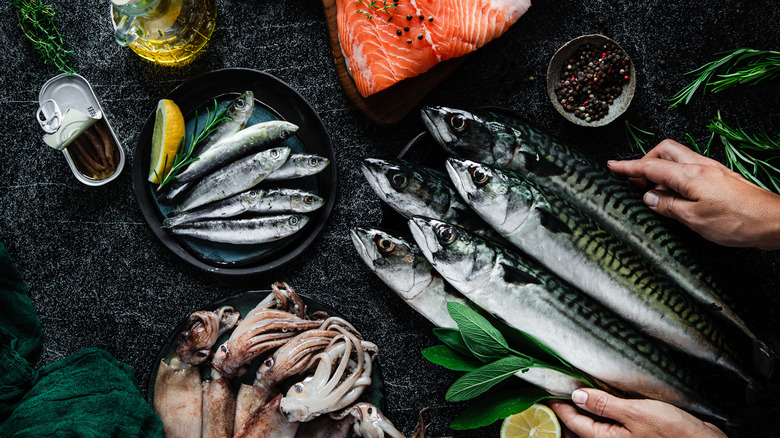Why Is Fish Not Considered Meat During Lent?
When asked if fish qualifies as meat, most of us would probably say "yes." After all, do you know any vegetarians, vegans, or other meat-abstaining folks who eat fish and say it doesn't count? However, there's a surprising amount debate surrounding this topic, especially in regards to religious practices like Lent.
Sources like Merriam-Webster and the United States Department of Agriculture agree that meat is the flesh of any animal used as food. However, if you ask a Catholic person, you may be surprised by their definition of fish versus meat — and which animals they classify as fish. Many of us known that Catholics over the age of 14 follow a special diet for Lent, including fasting and abstinence from meat on Friday. However, fish is fair game, and there are several theories as to why this is.
Some say it's a simple difference of definition, as the United States Conference of Catholic Bishops states that meat only comes from animals that live on land. In most religious sources, however, the tradition of not eating meat is done to avoid spilling blood on Fridays — the day of the week that Jesus Christ was killed. Additionally, theologians from medieval times promoted the practice as a way for Catholics to humble themselves and allow for greater spiritual progression by abstaining from the decadence, luxury, and bodily pleasure of meat.
Why meat is off the table for Lent, but fish can stay
The practice of fasting in Catholic tradition dates back to the Old Testament, and was used to deepen the relationship between practitioners and their god. However, the Lenten practice of abstaining from specific foods took on slightly different significance during the Middle Ages, influenced strongly by theologian Thomas Aquinas' text titled Summa Theologica. The text states that abstaining from eating flesh is important in recognition of Christ sacrificing his own flesh during his death.
The flesh that Catholics were advised to abstain from were "those foods which both afford most pleasure to the palate, and besides are a very great incentive to lust" (via CCEL). Referencing the teachings of Albert the Great, Europe's top biologist at the time, Aquinas argued that eating animals that were physically similar to humans (warm-blooded animals, that is) would be most pleasurable and nourishing, and therefore, could inadvertently increase feelings of lust and enhance virility.
Lent is all about discipline, imitating Christ's actions of humility and fasting, and undergoing self-control by abstaining from certain pleasures, making foods defined as "meat" not acceptable to eat. Since fish were less physically similar to Christ, however, they were deemed to be less pleasurable than land animals, making them safe to consume during Lent.
Which animals are considered fish?
Since the Catholic definition of meat differs from our popular understanding of the term, there are actually a lot of animals that some of us would never consider fish, but Catholics do. Obvious options like golden beer-battered fried fish or lemony baked salmon are delicious and nourishing meals to eat at appropriate times during Lent. Shellfish, alligators, turtles, and even snakes are also religiously-sound options.
The more surprising creatures in the church's classification of fish often gained the label due to dietary demands in certain regions. For example, in the 17th century, the Bishop of Quebec petitioned for the beaver, a semi-aquatic rodent, to join the ranks of fish, so that Catholics could consume them while observing Lent. The capybara, another semi-aquatic rodent that is commonly consumed in South America, has also become an honorary fish within the Catholic community. So while eating lavish meals or large quantities of any of these creatures are not in line with Lenten food traditions, modest servings of either are allowed.
If you don't have access to capybaras and personally shy away from eating snakes, endless ideas for light and easy fish dinners that are perfect for Lent are well within your grasp. And when Easter arrives and it's time to eat meat again, these delicious Easter recipes are sure to please your whole family.



